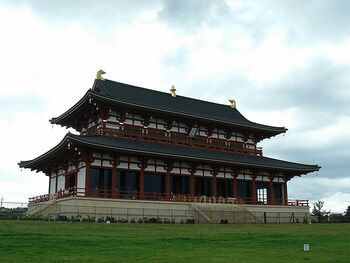

The Nara period takes its name from the site of Heijô-kyô in present day Nara, which served as the imperial capital from 710 until 784.
This period continued to witness the importation and adaptation of Chinese and Korean imperial and religious culture. It saw the expansion of Buddhist influence at the court, and both the Nihon Shoki and Kojiki were completed in the early Nara period. The period also saw the rise of the Fujiwara family, as well as the incorporation of southern Kyushu into the Japanese state (parts of Tôhoku would remain outside the Court's control into the 9th century, and beyond). The land was divided up into sixty-one provinces, the total population of which may have been around five million. The vast majority of these people continued to live in pit-dwellings, and to lead a bare agricultural existence, while the capital city of Heijô stood starkly apart, a microcosm of Chinese elite culture transplanted into a Japan otherwise little changed from earlier periods.[1]
The Imperial bureaucracy swelled to around 6,000 in this period. Roughly two-thirds of these courtiers were engaged in matters related to the Imperial Household, while less than 2,000 of them managed the actual administrative affairs of the state. The administration of the provinces, which had previously been ruled by local clans in a sort of loose confederation, was now delegated to provincial governors appointed from the capital.[1] Military service was provided by a conscript army, based on the Chinese model and incorporating roughly 1/3 of all men between the ages of 21 and 60. This system proved ineffective and inefficient, however, and in 792, the emperor abandoned the conscript system in favor of hiring local warriors who, in exchange, were freed from their tax obligations. This system of local warriors being hired by the Court continued deep into the Heian period, and constitutes the origins of the samurai class.[2]
The capital was relocated to Nagaoka-kyô, a short distance north, in 784. The chief impetus for this is typically cited as being a desire to escape the growing political influence of entrenched Buddhist institutions, including Tôdai-ji and Kôfuku-ji.
The Imperial Court remained in Nagaoka for only ten years, however, before moving to Heian-kyô (i.e. Kyoto). As a result, these ten years are generally included by historians into the Nara Period, prior to the start of the Heian Period in 794.
History
Need more information...
| Previous Period Asuka Period |
Nara Period | Following Period Heian Period |
References
- Conrad Schirokauer, David Lurie, and Suzanne Gay, A Brief History of Japanese Civilization, Wadsworth Cengage (2013), 30-43.
- ↑ 1.0 1.1 Albert M. Craig, The Heritage of Japanese Civilization, Second Edition, Prentice Hall (2011), 15-16.
- ↑ Craig, 19-20.